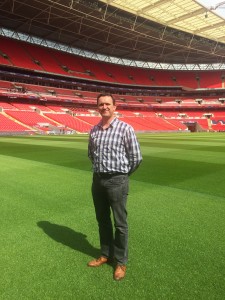 Calcined clay is a popular soil amendment used on baseball infields for water management and soil conditioning. Clay is heated at a high temperature, about 1500 degrees Fahrenheit to expand the clay forming calcined clay. On baseball fields calcined clay is used to fill in infield depressions caused by cleats and smooth the surface to provide a true baseball bounce, which contributes to the safety of the field. Calcined clay absorbs water that can help dry a field after a rainstorm, and firm the surface. Continue reading
Calcined clay is a popular soil amendment used on baseball infields for water management and soil conditioning. Clay is heated at a high temperature, about 1500 degrees Fahrenheit to expand the clay forming calcined clay. On baseball fields calcined clay is used to fill in infield depressions caused by cleats and smooth the surface to provide a true baseball bounce, which contributes to the safety of the field. Calcined clay absorbs water that can help dry a field after a rainstorm, and firm the surface. Continue reading
Author: Pamela Sherratt
Selective Creeping Bentgrass Control
By Pam Sherratt
Creeping bentgrass is considered a weed on athletic fields and lawns. It produces a superb playing surface for golf and it has great recuperative potential, but it’s shallow roots and lack of wear tolerance make it unsuitable for most athletic sports.
Tenacity (mesotrione) is the first herbicide that results in rapid, easy to visualize reductions in weedy perennial grasses, including creeping bentgrass. Best control, according to most research of creeping bentgrass, is achieved if three applications are made on 14-21 day intervals. Continue reading
Turf Selection Power Point
This is a power point file of a “turf selection for sports fields in Ohio” talk given by Pam Sherratt at the OSU Sports Turf Short Course, February, 2017.
Surface Playability Results
On W ednesday Nov. 16th the HCS 3370 Sports Turf Management class measured playing quality at the OTF Research Facility. Students measured green speed, surface firmness, hardness and soil moisture (at 3 inch depth) on a putting greens (USGA sand), a sports turf area (perennial ryegrass on sand:soil blend) and artificial turf.
ednesday Nov. 16th the HCS 3370 Sports Turf Management class measured playing quality at the OTF Research Facility. Students measured green speed, surface firmness, hardness and soil moisture (at 3 inch depth) on a putting greens (USGA sand), a sports turf area (perennial ryegrass on sand:soil blend) and artificial turf.
A stimpeter and soccer ball roll apparatus measured speed (ball roll). The Clegg Impact Hammer (Clegg) tested hardness (Gmax) of the turf. Firmness was tested with the Firmness Meter. Soil moisture was tested by the TDR 300 Soil Moisture Meter.
The results are summarized below.
In the comment section below, answer the following questions:
- Which surface was “fastest?
- How do you think speed affects ball performance in games like golf & soccer? Give an opinion as to why soccer players may prefer natural grass over synthetic/artificial.
- Which surface was “hardest”?
- How does soil moisture affect surface hardness?
You can answer these Qs for an extra bonus point!
Revitalizing Native Soil Fields This Fall
Weekly Update from Bri
What’s going on this week?
Well for starters welcome to all the new students in the various online certification courses OSU offers!
Next, let’s talk about research and the 2016 International Champions Cup at OSU Stadium!
Managing Sports Fields During Summer Heat & Drought Stress
The forecast for the next ten days looks dry and hot: average high air temps are currently at 85.5 degrees F and we are carrying a precipitation deficit of 2″ for the month of July (1″ actual precipitation versus 3″ normal). The average soil temperature at 4″ depth is currently 87.2F. These hot and dry conditions are far from ideal for cool-season grasses. This article will look at how cool-season grasses respond to heat and drought and how best to manage them to minimize turf injury.
Q&A With SGL’s Simon Gumbrill
With new supplemental light technology coming to the states, we wanted to learn a little more about this innovation in turf management.
The best person to ask about all this happens to be a leader in turf management with strong OSU ties. We posed these questions to Simon Gumbrill, who is the Area Manager for Stadium Grow Lighting (SGL), responsible for sales development and after sales care in the UK, Ireland and North America.
HS Students Eager to Learn about Sports Turf!
 Twelve high school students from Frontier Schools were recently enrolled into the Online Sports Turf Management Certificate Program offered by the Turfgrass Science team in the Dept. of Horticulture & Crop Science at The Ohio State University. Continue reading
Twelve high school students from Frontier Schools were recently enrolled into the Online Sports Turf Management Certificate Program offered by the Turfgrass Science team in the Dept. of Horticulture & Crop Science at The Ohio State University. Continue reading




